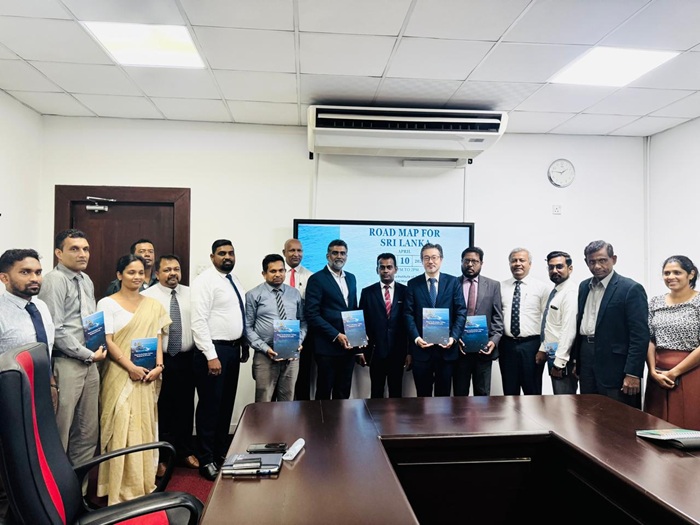
Sri Lanka officially launched the Marine Tourism Roadmap in Colombo recently, an initiative led by the Sri Lanka Tourism Development Authority (SLTDA) with support from the Asian Development Bank (ADB) under its technical assistance program TA9881 SRI: Supporting Tourism Resilience.
The initiative, which marked a major milestone in Sri Lanka’s tourism development efforts, lays the groundwork for a new chapter in tourism and the nation’s blue economy.
The Marine Tourism Roadmap was developed through an extensive process of data collection, stakeholder consultations and site visits conducted by the ADB-appointed international consultant together with officials of the SLTDA. The final validation of the Roadmap was done by the Marine Tourism Steering Committee, which included representatives from key marine-related public and private sector institutions. International expertise was provided by Ms. Aleksandra Dragozet (CEO & Founder – Sea Going Green), ADB’s appointed marine tourism consultant, whose guidance ensured the strategy aligned with global best practices for sustainable tourism. The SLTDA officials, Dr. Prasad Jayasuriya, Director-Tourism Planning, Development & Investments and Mr. S Dadeepan, Assistant Director-Tourism Planning & Development, coordinated all meetings, site visits and activities with relevant stakeholders and the Steering Committee.
The Marine Tourism Roadmap emphasizes a balanced approach between conservation and economic development, promoting eco-friendly activities such as diving, snorkelling, shipwreck diving and marine wildlife watching. These activities are designed to support local livelihoods while safeguarding Sri Lanka’s rich marine biodiversity, particularly coral reefs, marine mammals, and fragile coastal habitats that face increasing environmental pressure. The strategy outlines two categories of coastal destinations: areas covering Kalpitiya through Galle to Trincomalee, which possess established marine tourism industries; and areas covering Mannar, Jaffna and the North-Eastern coastal belt, which are recognized for their emerging tourism potential.
Notably, Sri Lanka’s ocean territory is nearly seven times larger than its landmass, highlighting the vast, untapped opportunities for marine-based tourism. The roadmap presents both short-term and long-term implementation strategies, aiming to develop sustainable marine tourism infrastructure, enhance visitor experiences, and ensure the protection and resilience of marine ecosystems in the years ahead.
The roadmap itself was the result of collaboration among stakeholders covering coastal areas of Negombo, Kalpitiya, Mannar, Jaffna, Mullativu, Trincomalee and Galle and also the Steering committee members representing 18 key marine-related public and private sector institutions, including the Presidential Secretariat, the Ministry of Tourism and the SLTDA. This unified approach ensured that the document reflects the diverse perspectives of stakeholders directly involved in marine and coastal tourism development.
The launch ceremony on 10 April was graced by Hon. Prof. Ruwan Ranasinghe – Deputy Minister of Tourism, as the Chief Guest. The event also saw the participation of Mr. Buddhika Hewawasam, Chairman of SLTDA, Mr. Takafumi Kadono, Country Director of ADB’s Sri Lanka Resident Mission, Mr. S. L. Naseer, Chairman of the Marine Tourism Steering Committee & Additional Secretary of the Ministry of Tourism and Dr. Prasad Jayasuriya, Director – Tourism Planning, Development & Investments of SLTDA, along with several other steering committee members and representatives of the ADB.
In his address, Hon. Prof. Ruwan Ranasinghe emphasized the critical importance of marine tourism in strengthening the national tourism strategy and assured full support of the government to implement the roadmap. He noted that sustainable marine tourism offers long-term opportunities for job creation, environmental protection, and community-based development.
SLTDA’s Chairman, Mr. Buddhika Hewawasam, underscored the importance of collective action in achieving the goals and objectives of the Marine Tourism Roadmap. He further noted that success will depend on effective coordination between the government, private sector, local communities, and environmental agencies.
ADB Country Director Mr. Takafumi Kadono highlighted the ADB’s continued commitment to supporting marine tourism in Sri Lanka. He noted that the roadmap serves as a model of strategic planning and confirmed ADB’s interest in supporting a pilot project in Passikudah to catalyze future developments in marine tourism.
This launch event—though simple in form—marked a vital moment in Sri Lanka’s journey towards more sustainable, inclusive, and resilient tourism development. With the Marine Tourism Roadmap now in place, Sri Lanka is poised to transform its coastal belt into a world-class marine tourism destination that balances economic opportunity with environmental stewardship.
By implementing these actionable recommendations and fostering collaboration across sectors, Sri Lanka’s marine tourism sector is set to become a key driver of the country’s tourism growth, job creation, and ecological preservation in the years to come. (Newswire)
